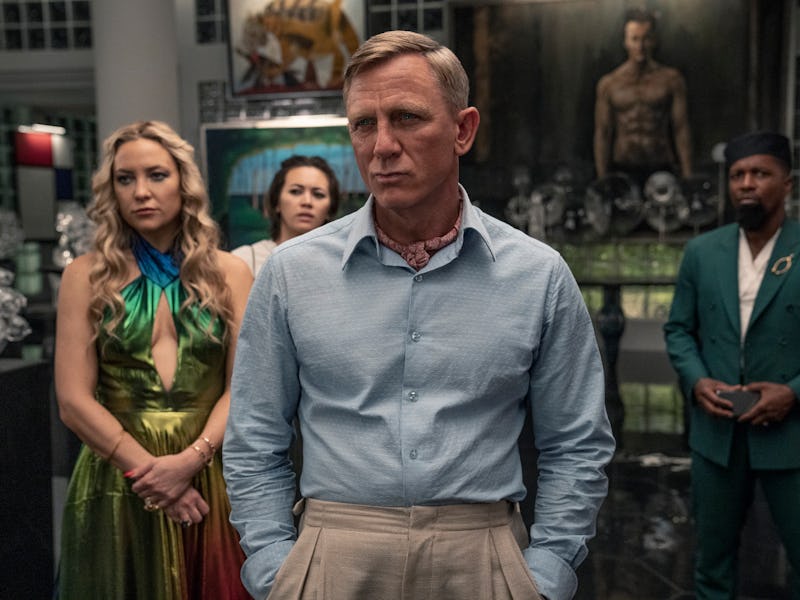How the ending of Glass Onion: A Knives Out Mystery explains its title
Benoit Blanc advises not to think so hard, because [SPOILER] is “an idiot.”

In the lyrics for “Glass Onion” by The Beatles, the iconic rockers from Liverpool mock their own listeners for reading way too much into the symbolic imagery found in their music. “Looking through a glass onion” is to seek understanding of complexity when there is none.
Filmmaker Rian Johnson isn’t quite making fun of his audience with his latest movie, Glass Onion: A Knives Out Mystery. But as gentleman detective Benoit Blanc clearly points out in the film’s third act: The culprit is a huge idiot, and everything is actually obvious — even the ending.
Warning: Spoilers for Knives Out: A Glass Onion Mystery below.
In Knives Out: A Glass Onion Mystery, now streaming on Netflix, Daniel Craig’s dapper, manners-minded investigator from 2019’s Knives Out crashes a private party on a remote Greek island hosted by ego-centric tech billionaire Miles Bron (Edward Norton).
As the movie slowly reveals, Blanc was invited — or rather, hired — by Helen Brand (Janelle Monáe), the identical twin sister of Miles’ former business partner “Andi” who was ousted by him and socially excised by everyone else in their circle. Helen suspects Andi was murdered by someone in the group, and asks Blanc for help to find out.
Daniel Craig’s Benoit Blanc returns in Glass Onion: A Knives Out Mystery, streaming now on Netflix.
Throughout Glass Onion, the characters in Johnson’s movie refer to the image of a glass onion, and there also happens to be an elaborate glass dome that sits atop Miles’ absurdly expensive home. There’s verbal mention of what glass onions are as well, as complex concepts and ideas that one can still see through.
Johnson plays with this symbolism throughout Glass Onion, caking on layers of possibilities, suspects, and misdirects even though the most obvious answers are sitting in plain sight.
Central to Glass Onion is why anyone would kill Andi, whose death happens off screen and before the film (but is seen via flashback from the killer’s point of view). The backstory is that Miles and Andi were business partners who founded Alpha, a cutting-edge conglomerate (think Amazon crossed with Tesla crossed with Lockheed Martin). The origins of Alpha lies on a bar napkin where Andi first sketched out the idea. But Miles ousted Andi for her share of the Alpha pie, and in subsequent hearings, their friends — all in need of money and security — sided with Miles, testifying that he was the sole founder.
With Andi dead (which is not yet public information), the only motive Blanc can figure is that the killer didn’t want Andi saying anything that would leave them vulnerable to perjury.
But who has the napkin? Who killed Andi? And who poisoned Duke (Dave Bautista), one of the guests and one of Andi’s ex-friends? Again: You don’t have to think hard about this one. The culprit is one of the most obvious faces standing in the movie’s promotional materials, trailers, and all throughout the movie itself. The one responsible for it all ... is Miles Bron.
Why did Miles kill Andi? Why did Miles poison Duke?
Yeah, this guy.
Once again, Benoit Blanc advises not to think too hard.
Miles killed Andi to stop her from ever telling the truth that she is the true originator of Alpha. And Miles killed Duke (with pineapple juice, triggering his allergy) because Duke learned about Andi’s death during the party, and threatened to blackmail Miles with the information.
As for where that crucial napkin was and who had it? Well, it was Miles, who kept it in his office, for anyone to see, while claiming it to be a replica.
Ultimately, the thrill of Glass Onion isn’t the answers to its biggest questions, but how it unmasks them. Glass Onion expands the twisty-turvy scheming of Knives Out into something that is far bigger and more intricately-designed, yet the actual story remains so simple that even a child could see through it. In a strange way, that makes Johnson’s latest the perfect new movie to watch with the whole family. Just as long as they don’t ask too many questions.
Glass Onion: A Knives Out Mystery is streaming now on Netflix.
This article was originally published on